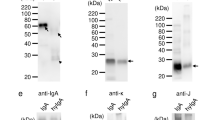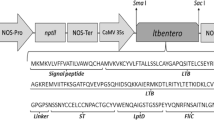Abstract
Main conclusion
An edible plant was tested as a host for the production of secretory monoclonal IgA against Shiga toxin 1 (Stx1). The lettuce-derived IgA completely protected Vero cells from Stx1.
Abstract
Secretory immunoglobulin A (SIgA) is thought to control mucosal infections and thus it may be applicable to oral passive immunotherapy. Edible plants are candidate hosts for producing oral formulations with SIgA against pathogenic agents. We previously established a recombinant IgA specific for the B subunit of Shiga toxin 1 (Stx1B) consisting of the Fab fragment of Stx1B-specific monoclonal IgG and the Fc region of IgA (hyIgA). Here, we developed transgenic lettuce (Lactuca sativa) that produces hyIgA in a secretory form (S-hyIgA). An Arabidopsis-derived light-harvesting complex II (LHCB) promoter was used for the expression of all four transgenes (hyIgA heavy, light and j chains, and secretory component). Agrobacterium-mediated transformation was carried out to introduce genes into lettuce leaf discs by means of a single vector harboring all four transgenes. Consistent with the tissue specificity of the LHCB promoter, the expression of hyIgA transgenes was observed in leaf and stem tissues, which contain chloroplasts, at the mRNA and protein levels. The leaves produced hyIgA in a more than tenfold higher yield as compared with stems. The lettuce-derived S-hyIgA was found to bind to Stx1B in a dose-dependent manner by means of ELISA. A leaf extract of the transgenic lettuce completely neutralized the cytotoxicity of Stx1 against Vero cells, which are highly susceptible to Stx1. In conclusion, we established a transgenic lettuce producing a secretory form of hyIgA that can bind bacterial toxin. The results indicate that edible practical plants containing S-hyIgA will provide a possible means for immunotherapy for food poisoning.






Similar content being viewed by others
Abbreviations
- AmS:
-
Ammonium sulfate
- DIG:
-
Digoxigenin
- EHEC:
-
Enterohemorrhagic Escherichia coli
- FBS:
-
Fetal bovine serum
- FW:
-
Fresh weight
- Gb3 :
-
Globotriaosylceramide
- HRP:
-
Horseradish peroxidase
- Hc:
-
Heavy chain
- hyIgA:
-
Hybrid-IgG/IgA
- Jc:
-
Joining chain
- Lc:
-
Light chain
- LHCB:
-
Light-harvesting complex II
- mAb:
-
Monoclonal antibody
- MS:
-
Murashige and Skoog
- PBS:
-
Phosphate-buffered saline
- pIgR:
-
Polymeric immunoglobulin receptor
- SC:
-
Secretory component
- S-hyIgA:
-
Secretory hybrid-IgG/IgA
- SIgA:
-
Secretory IgA
- Stx1:
-
Shiga toxin 1
- Stx1A:
-
A subunit of Stx1
- Stx1B:
-
B subunit of Stx1
- T-DNA:
-
Transfer-DNA
- TSP:
-
Total soluble protein
- UBQ:
-
Ubiquitin extension protein
- WT:
-
Wild-type
References
Békássy ZD, Calderon Toledo C, Leoj G, Kristoffersson A, Leopold SR, Perez MT, Karpman D (2011) Intestinal damage in enterohemorrhagic Escherichia coli infection. Pediatr Nephrol 26:2059–2071. https://doi.org/10.1007/s00467-010-1616-9
Berdoz J, Blanc CT, Reinhardt M, Kraehenbuhl JP, Corthésy B (1999) In vitro comparison of the antigen-binding and stability properties of the various molecular forms of IgA antibodies assembled and produced in CHO cells. Proc Natl Acad Sci USA 96:3029–3034. https://doi.org/10.1073/pnas.96.6.3029
Chan YS, Ng TB (2016) Shiga toxins: from structure and mechanism to applications. Appl Microbiol Biotechnol 100:1597–1610. https://doi.org/10.1007/s00253-015-7236-3
Clough SJ, Bent AF (1998) Floral dip: a simplified method for Agrobacterium-mediated transformation of Arabidopsis thaliana. Plant J 16:735–743. https://doi.org/10.1046/j.1365-313x.1998.00343.x
Daniell H, Streatfield SJ, Wycoff K (2001) Medical molecular farming: production of antibodies, biopharmaceuticals and edible vaccines in plants. Trends Plant Sci 6:219–226. https://doi.org/10.1016/S1360-1385(01)01922-7
Desai PN, Shrivastava N, Padh H (2010) Production of heterologous proteins in plants: strategies for optimal expression. Biotechnol Adv 28:427–435. https://doi.org/10.1016/j.biotechadv.2010.01.005
Endo M (2016) Tissue-specific circadian clocks in plants. Curr Opin Plant Biol 29:44–49. https://doi.org/10.1016/J.PBI.2015.11.003
Hirai T, Shohael AM, Kim YW, Yano M, Ezura H (2011) Ubiquitin promoter-terminator cassette promotes genetically stable expression of the taste-modifying protein miraculin in transgenic lettuce. Plant Cell Rep 30:2255–2265. https://doi.org/10.1007/s00299-011-1131-x
Johannes L, Römer W (2010) Shiga toxins—from cell biology to biomedical applications. Nat Rev Microbiol 8:105–116. https://doi.org/10.1038/nrmicro2279
Johansen FE, Braathen R, Brandtzaeg P (2000) Role of J chain in secretory immunoglobulin formation. Scand J Immunol 52:240–248. https://doi.org/10.1046/j.1365-3083.2000.00790.x
Juarez P, Virdi V, Depicker A, Orzaez D (2016) Biomanufacturing of protective antibodies and other therapeutics in edible plant tissues for oral applications. Plant Biotechnol J 14:1791–1799. https://doi.org/10.1111/pbi.12541
Kawazu Y, Imanishi S, Yamaguchi H, Ohyama A, Nunome T, Miyatake K, Fukuoka H (2019) Lettuce polyubiquitin promoter-terminator promotes transgene expression transcriptionally in lettuce and translationally in both lettuce and Arabidopsis. Hort J 88:83–91. https://doi.org/10.2503/hortj.UTD-022
Kwon KC, Verma D, Singh ND, Herzog R, Daniell H (2013) Oral delivery of human biopharmaceuticals, autoantigens and vaccine antigens bioencapsulated in plant cells. Adv Drug Deliv Rev 65:782–799. https://doi.org/10.1016/j.addr.2012.10.005
Kwon KC, Sherman A, Chang WJ, Kamesh A, Biswas M, Herzog RW, Daniell H (2018) Expression and assembly of largest foreign protein in chloroplasts: oral delivery of human FVIII made in lettuce chloroplasts robustly suppresses inhibitor formation in haemophilia A mice. Plant Biotechnol J 16:1148–1160. https://doi.org/10.1111/pbi.12859
Lee MS, Koo S, Jeong DG, Tesh VL (2016) Shiga toxins as multi-functional proteins: induction of host cellular stress responses, role in pathogenesis and therapeutic applications. Toxins (Basel) 8:77. https://doi.org/10.3390/toxins8030077
Lelivelt CLC, McCabe MS, Newell CA, deSnoo CB, van Dun KMP, Birch-Machin I, Gray JC, Mills KHG, Nugent JM (2005) Stable plastid transformation in lettuce (Lactuca sativa L.). Plant Mol Biol 58:763–774. https://doi.org/10.1007/s11103-005-7704-8
Lim S, Ashida H, Watanabe R et al (2011) Production of biologically active human thioredoxin 1 protein in lettuce chloroplasts. Plant Mol Biol 76:335–344. https://doi.org/10.1007/s11103-011-9745-5
Lindh E (1975) Increased resistance of immunoglobulin A dimers to proteolytic degradation after binding of secretory component. J Immunol 114:284–286
Longet S, Miled S, Lötscher M, Miescher SM, Zuercher AW, Corthésy B (2013) Human plasma-derived polymeric IgA and IgM antibodies associate with secretory component to yield biologically active secretory-like antibodies. J Biol Chem 288:4085–4094. https://doi.org/10.1074/jbc.M112.410811
Ma JK, Hiatt A, Hein M, Vine ND, Wang F, Stabila P, van Dolleweerd C, Mostov K, Lehner T (1995) Generation and assembly of secretory antibodies in plants. Science 268:716–719. https://doi.org/10.1126/science.7732380
Matsui T, Asao H, Ki M, Sawada K, Kato K (2009) Transgenic lettuce producing a candidate protein for vaccine against edema disease. Biosci Biotechnol Biochem 73:1628–1634. https://doi.org/10.1271/bbb.90129
Matsui T, Takita E, Sato T et al (2011) Production of double repeated B subunit of Shiga toxin 2e at high levels in transgenic lettuce plants as vaccine material for porcine edema disease. Transgenic Res 20:735–748. https://doi.org/10.1007/s11248-010-9455-9
Mitra A, Choi HK, An G (1989) Structural and functional analyses of Arabidopsis thaliana chlorophyll a/b-binding protein (cab) promoters. Plant Mol Biol 12:169–179. https://doi.org/10.1007/BF00020502
Mitra A, Han J, Zhang ZJ, Mitra A (2009) The intergenic region of Arabidopsis thaliana cab1 and cab2 divergent genes functions as a bidirectional promoter. Planta 229:1015–1022. https://doi.org/10.1007/s00425-008-0859-1
Miyashita S, Matsuura Y, Miyamoto D, Suzuki Y, Imai Y (1999) Development of recombinant B subunit of Shiga-like toxin 1 as a probe to detect carbohydrate ligands in immunochemical and flowcytometric application. Glycoconj J 16:697–705. https://doi.org/10.1023/A:1007107425891
Nakanishi K, Narimatsu S, Ichikawa S, Tobisawa Y, Kurohane K, Niwa Y, Kobayashi H, Imai Y (2013) Production of hybrid-IgG/IgA plantibodies with neutralizing activity against Shiga toxin 1. PLoS One 8:e80712. https://doi.org/10.1371/journal.pone.0080712
Nakanishi K, Morikane S, Ichikawa S, Kurohane K, Niwa Y, Akimoto Y, Matsubara S, Kawakami H, Kobayashi H, Imai Y (2017) Protection of human colon cells from Shiga toxin by plant-based recombinant secretory IgA. Sci Rep 7:45843. https://doi.org/10.1038/srep45843
Nakanishi K, Morikane S, Hosokawa N, Kajihara Y, Kurohane K, Niwa Y, Kobayashi H, Imai Y (2019) Plant-derived secretory component forms secretory IgA with shiga toxin 1-specific dimeric IgA produced by mouse cells and whole plants. Plant Cell Rep 38:161–172. https://doi.org/10.1007/s00299-018-2358-6
Paul M, Reljic R, Klein K, Drake PM, van Dolleweerd C, Pabst M, Windwarder M, Arcalis E, Stoger E, Altmann F, Cosgrove C, Bartolf A, Baden S, Ma JK (2014) Characterization of a plant-produced recombinant human secretory IgA with broad neutralizing activity against HIV. MAbs 6:1585–1597. https://doi.org/10.4161/mabs.36336
Phalipon A, Cardona A, Kraehenbuhl JP, Edelman L, Sansonetti PJ, Corthésy B (2002) Secretory component: a new role in secretory IgA-mediated immune exclusion in vivo. Immunity 17:107–115. https://doi.org/10.1016/S1074-7613(02)00341-2
Schüller S (2011) Shiga toxin interaction with human intestinal epithelium. Toxins (Basel) 3:626–639. https://doi.org/10.3390/toxins3060626
Schüller S, Frankel G, Phillips AD (2004) Interaction of Shiga toxin from Escherichia coli with human intestinal epithelial cell lines and explants: Stx2 induces epithelial damage in organ culture. Cell Microbiol 6:289–301. https://doi.org/10.1046/j.1462-5822.2004.00370.x
Su J, Zhu L, Sherman A, Wang X, Lin S, Kamesh A, Norikane JH, Streatfield SJ, Herzog RW, Daniell H (2015) Low cost industrial production of coagulation factor IX bioencapsulated in lettuce cells for oral tolerance induction in hemophilia B. Biomaterials 70:84–93. https://doi.org/10.1016/j.biomaterials.2015.08.004
Tanikawa T, Ishikawa T, Maekawa T, Kuronane K, Imai Y (2008) Characterization of monoclonal immunoglobulin A and G against Shiga toxin binding subunits produced by intranasal immunization. Scand J Immunol 68:414–422. https://doi.org/10.1111/j.1365-3083.2008.02153.x
Tesh VL (2010) Induction of apoptosis by Shiga toxins. Future Microbiol 5:431–453. https://doi.org/10.2217/fmb.10.4
Tobisawa Y, Maruyama T, Tanikawa T, Nakanishi K, Kurohane K, Imai Y (2011) Establishment of recombinant hybrid-IgG/IgA immunoglobulin specific for Shiga toxin. Scand J Immunol 74:574–584. https://doi.org/10.1111/j.1365-3083.2011.02617.x
Zumbrun SD, Melton-Celsa AR, Smith MA, Gilbreath JJ, Merrell DS, O’Brien AD (2013) Dietary choice affects Shiga toxin-producing Escherichia coli (STEC) O157:H7 colonization and disease. Proc Natl Acad Sci USA 110:E2126–E2133. https://doi.org/10.1073/pnas.1222014110
Acknowledgements
This work was supported by Japan Society for the Promotion of Science (JSPS) KAKENHI Grant Numbers JP15H04660 and JP25670063 to YI; JP25·10915 to KN as well as by a research grant from the University of Shizuoka. We thank Dr. Hiroshi Asao (Nara Prefecture Agricultural Research and Development Center) for guidance for transformation of lettuce; and Mr. N.J. Halewood for language editing services.
Author information
Authors and Affiliations
Corresponding author
Ethics declarations
Conflict of interest
The authors declare that they have no conflict of interest.
Additional information
Publisher's Note
Springer Nature remains neutral with regard to jurisdictional claims in published maps and institutional affiliations.
Electronic supplementary material
Below is the link to the electronic supplementary material.
Rights and permissions
About this article
Cite this article
Nakanishi, K., Matsuda, M., Ida, R. et al. Lettuce-derived secretory IgA specifically neutralizes the Shiga toxin 1 activity. Planta 250, 1255–1264 (2019). https://doi.org/10.1007/s00425-019-03215-1
Received:
Accepted:
Published:
Issue Date:
DOI: https://doi.org/10.1007/s00425-019-03215-1




